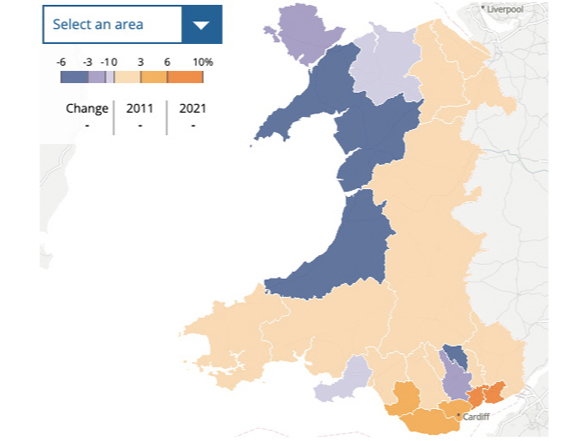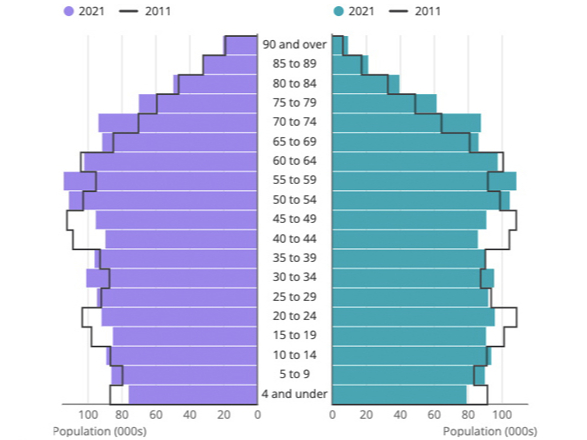THE first results of the 2021 census are in – and they show that Ceredigion and Gwynedd has seen its population shrink over the last decade. And not only are there fewer of us, but there are also more older people too.
The census takes place every 10 years, with every household in the UK required to take part.
The latest snapshot of England and Wales was captured on 21 March, 2021.

On census day, 71,500 people were living in Ceredigion – down 6 per cent from 75,922 in 2011, when the last census was carried out.
This also means the population density has fallen to 40 per square kilometre, down from 43 in 2011.
On census day, 117,400 people were living in Gwynedd – down 4 per cent from 121,874 in 2011, giving the county a population density of 46 per square kilometre, down from 48 in 2011.
The census shows the balance of men and women in the area has changed – Ceredigion’s population is now 49 per cent male and 51 per cent female, meaning there is now a higher proportion of women in the area than 10 years ago.

In 2011, people living in Ceredigion were 49.8 per cent male and 50.2 per cent female.
Gwynedd’s population is now 49 per cent male and 51 per cent female compared to 49.2 per cent male and 50.8 per cent female in 2011.
Powys’ population is now 49.3 per cent male and 50.7 per cent female compared in 2011 to 49.4 per cent male and 50.6 per cent female.
But the biggest changes have been in our aging population.
A decade ago the population of Ceredigion was made up of 9 per cent under-10s and 20.7 per cent over-65s, but this had changed to 8.4 per cent and 25.7 per cent respectively by 2021.
There were 18,400 people aged 65 and over living in Ceredigion on census day last year – up from 15,705 in 2011, when the census was last carried out.
It’s a similar trend in Gwynedd and Powys. A decade ago, the population was made up of 10.7 per cent under-10s and 20.6 per cent over-65s, but this had changed to 9.8 per cent and 23.3 per cent respectively by 2021.
The Powys population was made up of 9.9 3 per cent under-10s and 22.73 per cent over-65s, but this had changed to 9.23 per cent and 27.83 per cent respectively by 2021. The proportion of over-65s living in Powys rose over the last decade – from 22.73 per cent to 27.83 per cent.
There were 37,800 people aged 29 and under living in Powys on 21 March last year, who accounted for 28.43 per cent of the population – down from 41,478 (31.23 per cent) in 2011.
There were 24,200 people aged 29 and under living in Ceredigion on 21 March last year, who accounted for 33.8 per cent of the population – down from 28,897 (38.1 per cent) in 2011.
This trend is reflected across England and Wales as a whole, where the population is ageing.
The census was taken at a time when coronavirus restrictions were still in place
There were 40,100 people aged 29 and under living in Gwynedd on March 21 last year, who accounted for 34.2 per cent of the population – down from 44,146 (36.2 per cent) in 2011.
Future releases will include figures on ethnicity, religion, the labour market, education and housing plus – for the first time – information on UK armed forces veterans, sexual orientation and gender identity.
In Wales, Rebecca Evans MS, the Minister for Finance and Local Government said the 2021 Census was a success.
“Delivered against the backdrop of the coronavirus pandemic, the first digital-first census achieved a response rate of more than 96 per cent in Wales, with more than two thirds of households completing it online,” the minister said.
“This household response rate far exceeded the ONS’s target of 94 per cent nationally and local response rates were above the target of 80 per cent in each local authority area. I thank the Welsh public for their response.”
Across England and Wales, the total population grew 6.3 per cent over the past decade, from 56,075,912 in 2011 to 59,597,300 last year.
This was the largest population ever recorded through a census in England and Wales. The population of both nations grew by more than 3.5 million (6.3 per cent) in 2011, when it was 56,075,912.
There were 30,420,100 women (51.0 per of the overall population) and 29,177,200 men (49.0 per cent) in England and Wales. This included a 1.43 per cent increase in Wales, where the population rose to 3,107,500 from 3,063,456 in 2011.
There were 24.8 million households in England and Wales on census day 2021, up from 23.4 million in 2011, with an average of 2.4 people in each household – the same as in 2011.
— Cambrian News data services





Comments
This article has no comments yet. Be the first to leave a comment.